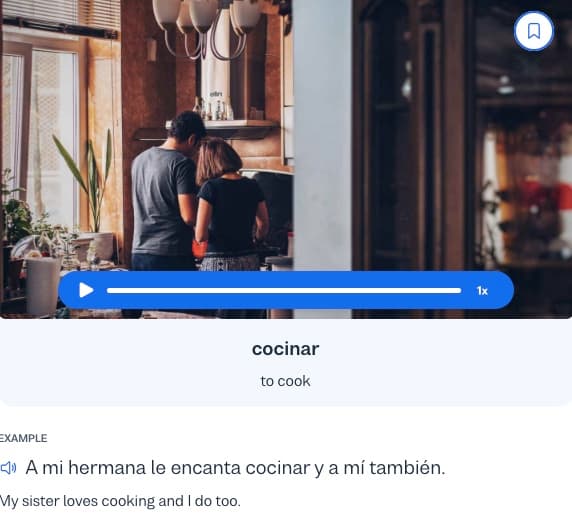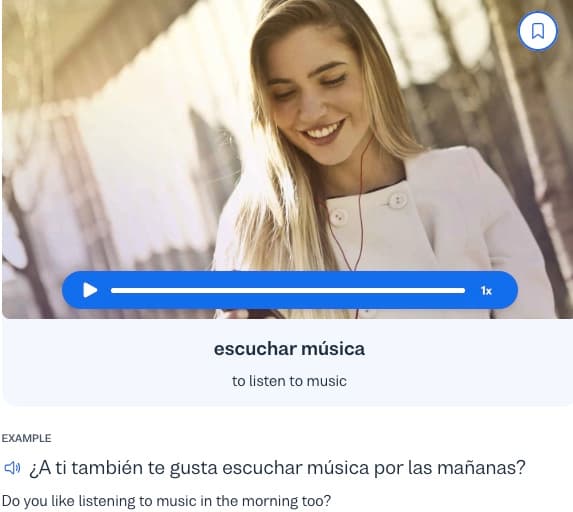I want to learn...
Understanding the present simple tense is fundamental for effective communication. In the direst situations, you can likely get anywhere in the Spanish-speaking world, by only knowing this tense.
In this article, we will explore the key concepts of the conjugation of the present simple tense in Spanish. By grasping these essential elements, you will be able to confidently express present actions, habits, and general truths in Spanish.
Present simple tense in Spanish: Overview
The present simple tense, also known as the presente de indicativo, is used to express habitual actions, general truths, or ongoing states in the present. To conjugate regular verbs in the present simple tense, follow these general rules:
Present simple tense
| Pronoun | -ar conjugations | -er conjugations | -ir conjugations |
|---|---|---|---|
| Yo | -o | -o | -o |
| Tú | -as | -es | -es |
| Él / Ella / Usted | -a | -e | -e |
| Nosotros / Nosotras | -amos | emos | -imos |
| Vosotros / Vosotras Note: Although usted / ustedes refers to the second person (singular / plural) its conjugation coincides with that of the third person. The second person plural always has an accent mark in the present simple unless it is a word with only one syllable. | -áis | -éis | -ís |
| Ellos / Ellas/ Ustedes | -an | -en | -en |
Simple present tense conjugations
| Pronoun | -ar example | -er example | -ir example |
|---|---|---|---|
| Yo | Hablo (I speak) | Como (I eat) | Vivo (I live) |
| Tú | Hablas (You speak) | Comes (You eat) | Vives (You live) |
| Él / Ella / Usted | Habla (He / She / You - formal speak) | Come (He / She / You - formal eat) | Vive (He / She / You - formal live) |
| Nosotros / Nosotras | Hablamos (We speak) | Comemos (We eat) | Vivimos (We live) |
| Vosotros / Vosotras | Habláis (You all speak) | Coméis (You all eat) | Vivís (You all live) |
| Ellos / Ellas / Ustedes | Hablan (They / You all - formal speak) | Comen (They / You all - formal eat) | Viven (They / You all - formal live) |
Irregular verbs
While regular verbs follow conjugation patterns, many common Spanish verbs are irregular in the present tense. Irregular verbs have unique conjugations that must be memorized.
Irregular verbs conjugated examples
| Pronoun | Ser (to be) | Ir (to go) | Tener (to have) |
|---|---|---|---|
| Yo | Soy | Voy | Tengo |
| Tú | Eres | Vas | Tienes |
| Él / Ella / Usted | Es | Va | Tiene |
| Nosotros / Nosotras | Somos | Vamos | Tenemos |
| Vosotros / Vosotras | Sois | Vais | Tenéis |
| Ellos / Ellas / Ustedes | Son | Van | Tienen |
Stem-changing verbs
In addition to irregular verbs, Spanish also has stem-changing verbs, also known as "boot verbs" due to their unique conjugation patterns.
Stem-changing verbs undergo changes in the stem vowel in the present tense for all subjects except nosotros / nosotras and vosotros / vosotras.
E → IE: Verbs with an -e- in the stem that changes to -ie in all forms except nosotros / nosotras and vosotros / vosotras.
For example,
Yo quiero (I want)
Tú quieres (You want)
Él / Ella / Usted quiere (He / She / You - formal want)
Nosotros / Nosotras queremos (We want)
Vosotros / Vosotras queréis (You all want)
Ellos / Ellas / Ustedes quieren (They / You all - formal want)
E → I: Verbs with an -e- in the stem that changes to -e in all forms except nosotros / nosotras and vosotros / vosotras
For example,
Yo pido (I ask for)
Tú pides (You ask for)
Él / Ella / Usted pide (He/She/You ask for)
Nosotros / Nosotras pedimos (We ask for)
Vosotros /Vosotras pedís (You all ask for)
Ellos / Ellas / Ustedes piden (They / You all ask for)
O → UE: Verbs with an -o- in the stem that changes to -ue in all forms except nosotros / nosotras and vosotros / vosotras
For example,
Yo puedo (I can)
Tú puedes (You can)
Él / Ella / Usted puede (He / She / You - formal can)
Nosotros / Nosotras podemos (We can)
Vosotros / Vosotras podéis (You all can)
Ellos / Ellas /Ustedes pueden (They / You all - formal can)
Spanish, like any language, has its fair share of irregularities and exceptions. Some verbs have spelling changes in certain conjugations, while others may undergo stem changes in the present tense.
It is essential to consult a reliable Spanish grammar resource, like Busuu, to learn and practice these special cases.
Mastering the present simple tense in Spanish is a crucial step for any basic-level student. By understanding the rules and key concepts of this Spanish tense, you can confidently communicate present actions, habits, and general truths.
Remember to practice using regular, stem-changing, and irregular verbs and immerse yourself in Spanish language and culture to reinforce your understanding and fluency.
Newlanguages


